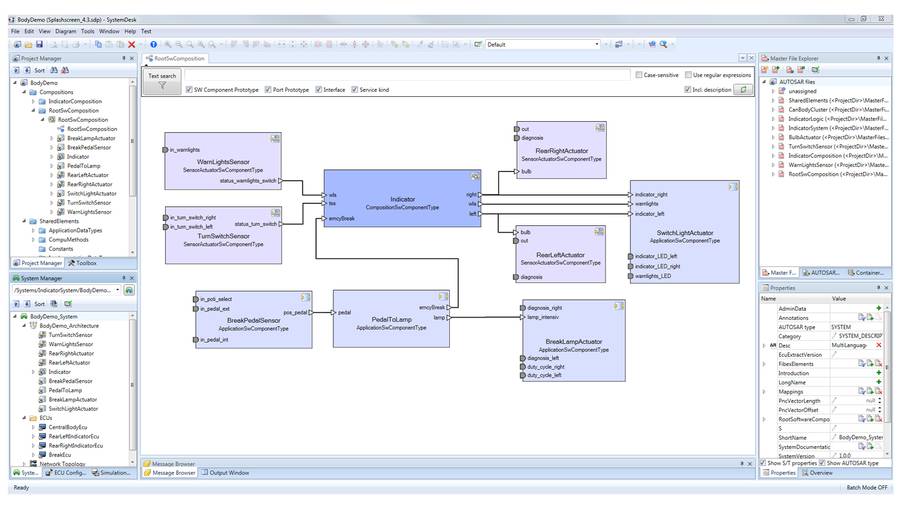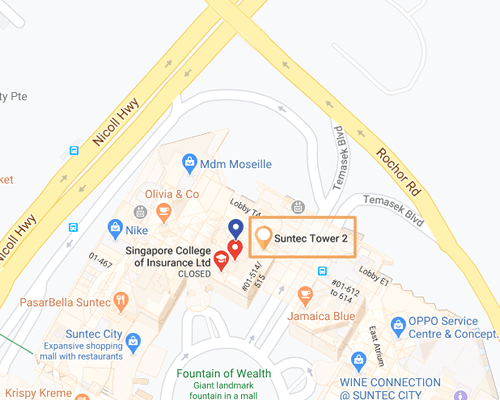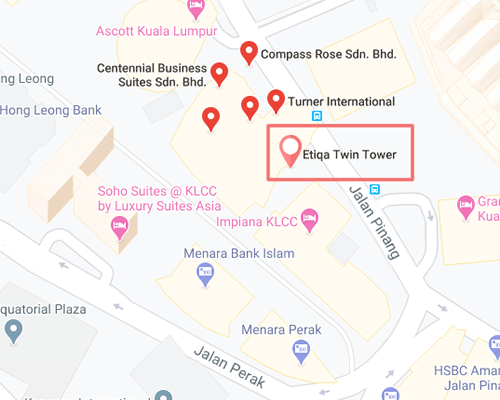SystemDesk
Modeling system architecture and generating virtual ECUs
SystemDesk is a system architecture tool that provides sophisticated and extensive support for modeling AUTOSAR architectures and systems for application software. Additionally, SystemDesk generates virtual ECUs (V-ECUs) out of the application software. The V-ECUs can be used as units under test with the dSPACE simulation platforms, such as the PC-based simulation platform VEOS for validating the ECU software.
- Efficient modeling, including plausibility checks and correction suggestions
- Flexible generation of virtual ECUs, e.g., with your own basic software, for early validation with VEOS
- Complete and documented API for automation

At A Glance
Application Areas
SystemDesk can be used for two application areas. As a system architecture tool, it provides sophisticated and extensive support for modeling AUTOSAR architectures and systems for application software. Comprehensive graphical support facilitates the first use but also enables efficient and error-reduced working in large-scale projects.
The second application area creating virtual ECUs (V-ECUs) for validating ECU software at an early development stage. V-ECUs contain series code for the functionalities to be tested, either at application level only or also including basic software. They can then be used as unit under test with the dSPACE simulation platforms, such as the PC-based simulation platform VEOS.
Key Benefits
- Efficient use due to convenient dialogs, editors, and diagrams
- Easy and fast generation of V-ECUs based on AUTOSAR and non-AUTOSAR software for validation purposes
- V-ECUs including application software and dSPACE basic software for testing application software or your own basic software for integration tests
- Reliable project quality by means of comprehensive rule-based validation of consistency and correctness
- Convenient development process due to the automation of recurring tasks or remote control with third-party tools via the automation API
Functionality Overview
| Functionality | Description |
| AUTOSAR modeling | Modeling of software architectures and systems according to both Classic AUTOSAR and Adaptive AUTOSAR standard |
| Clear overview due to graphical modeling with diagrams | |
| Sophisticated editors and dialogs for easy and faultless data entry | |
| Data exchange: flexible and easy-to-configure import and export of ARXML files | |
| Complete support of the AUTOSAR meta model1) | |
| Import of communication matrices (DBC, LDF, FIBEX) | |
| Support of AUTOSAR Splittables lets you reimport splitted AUTOSAR elements without changing other parts | |
| V-ECU generation | V-ECU generation based on AUTOSAR-compliant and non-AUTOSAR-compliant code |
| Creating V-ECUs for the AUTOSAR Adaptive Platform | |
| For testing application software, V-ECUs can include dSPACE basic software | |
| For testing basic software or functions that require realistic basic software functions, production basic software can be integrated | |
| For testing application software, you can use the mostly automatic configuration and generation of required basic software modules | |
| Integration of your own basic software modules (optional), e.g., for diagnostics tests and test of the complete ECU software | |
| Let V-ECUs go to sleep state and wake up again during the simulation in VEOS | |
| Now supporting basic software based on the ICU, AUTOSAR MCAL modules for VEOS | |
| Include your own basic software in V-ECUs, now also based on these new MCAL modules: SPI (Serial Peripheral interface), APU (Angular Processing Unit) and LIN Slave | |
| Generation of A2L files including memory sections | |
| With a wrapper, existing Classic AUTOSAR Software Components can be turned into Adaptive Applications | |
| Process support | Comprehensive rule-based validation of the system architecture and ECU software regarding consistency, correctness, and completeness |
| Easy data exchange with dSPACE’s code generator, TargetLink | |
| Usable with every AUTOSAR-compliant basic software configuration tool | |
| Support of Classic AUTOSAR Revisions R4.4.0, R4.3.1, R4.3.0 R4.2.2, R4.2.1, R4.1.3, R4.1.2, R4.1.1, R4.0.3, and R4.0.2 | |
| Support of Adaptive AUTOSAR Release 18.10 | |
| Include functionalities for realistic sensor input to the V-ECU: to detect rising or falling edges or create angle-based events like for camshaft sensors | |
| Completely documented automation API for automating tasks such as report generation, software architecture creation, and automatic V-ECU generation | |
| Hyperlink connection between model elements and single requirements in a requirements management tool, such as IBM® Rational® DOORS® | |
| Scripts running on Python 3.6 |
Working with SystemDesk
SystemDesk supports the development process with numerous features for intuitive working:
- AUTOSAR-Compliant Modeling
Use SystemDesk’s authoring capabilities to create and edit software architecture and system descriptions according to the AUTOSAR standard. - Generation of Virtual ECUs for Simulation
Use SystemDesk to generate virtual ECUs (V-ECUs) that include dSPACE’s or your own basic software modules to get a realistic representation of the real ECU. The V-ECUs are based on AUTOSAR- or non-AUTOSAR-compliant code. Simulate the V-ECU with VEOS to validate your software in a PC-based simulation. - Dialogs and Diagrams
For an easy and efficient capture and configuration of common AUTOSAR data, SystemDesk offers convenient, preconfigured dialogs. Additionally, special diagrams of the software architecture and system elements help keep an overview of your model. - Data Exchange with TargetLink
You can exchange data seamlessly between SystemDesk and dSPACE’s production code generator, TargetLink. This gives you a secure process for including the actual functionality in the software architecture in a model-based development environment. - Project Validation
Use SystemDesk’s validation functionality to ensure that your AUTOSAR architecture is complete and consistent before giving it to a project partner for basic software (BSW) configuration and before generating a V-ECU – and save time by finding problems as early as possible. You can define your own validation rules to also check compliance with company-specific project requirements. - Complete and Documented Tool API
Use the open tool API to automate recurring design tasks and extend the features of SystemDesk according to project-specific requirements or even use it to create a completely automated tool chain for V-ECU generation. - Application Software and BSW Integration
For testing the ECU software, you can either combine your application software with dSPACE basic software (BSW) modules or import your own BSW. Importing your own production BSW lets you test your basic software or functions that require realistic BSW input, such as diagnostics functions. If your test focus is the application software, using the dSPACE BSW is more convenient, as it is automatically generated and configured according to the systems requirements.



